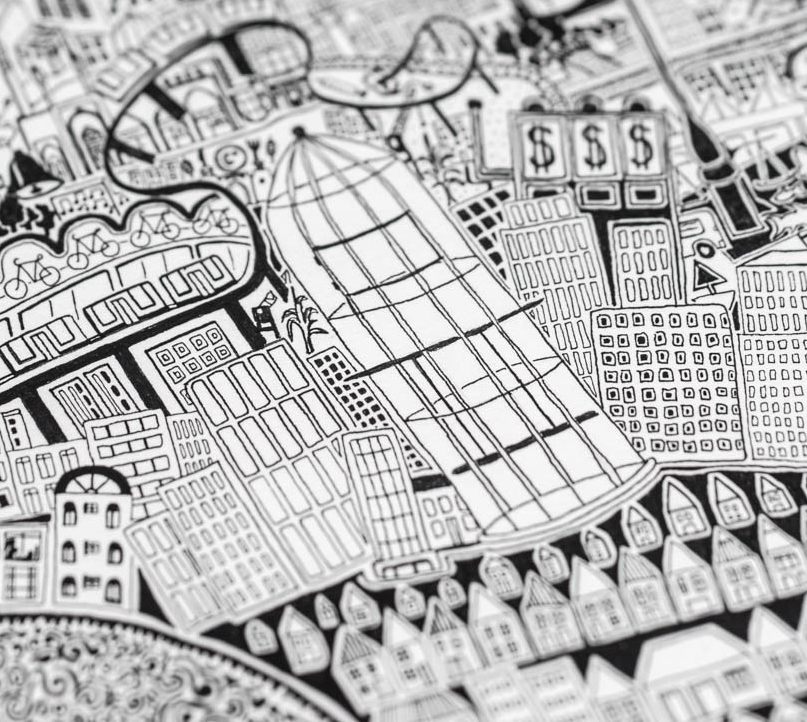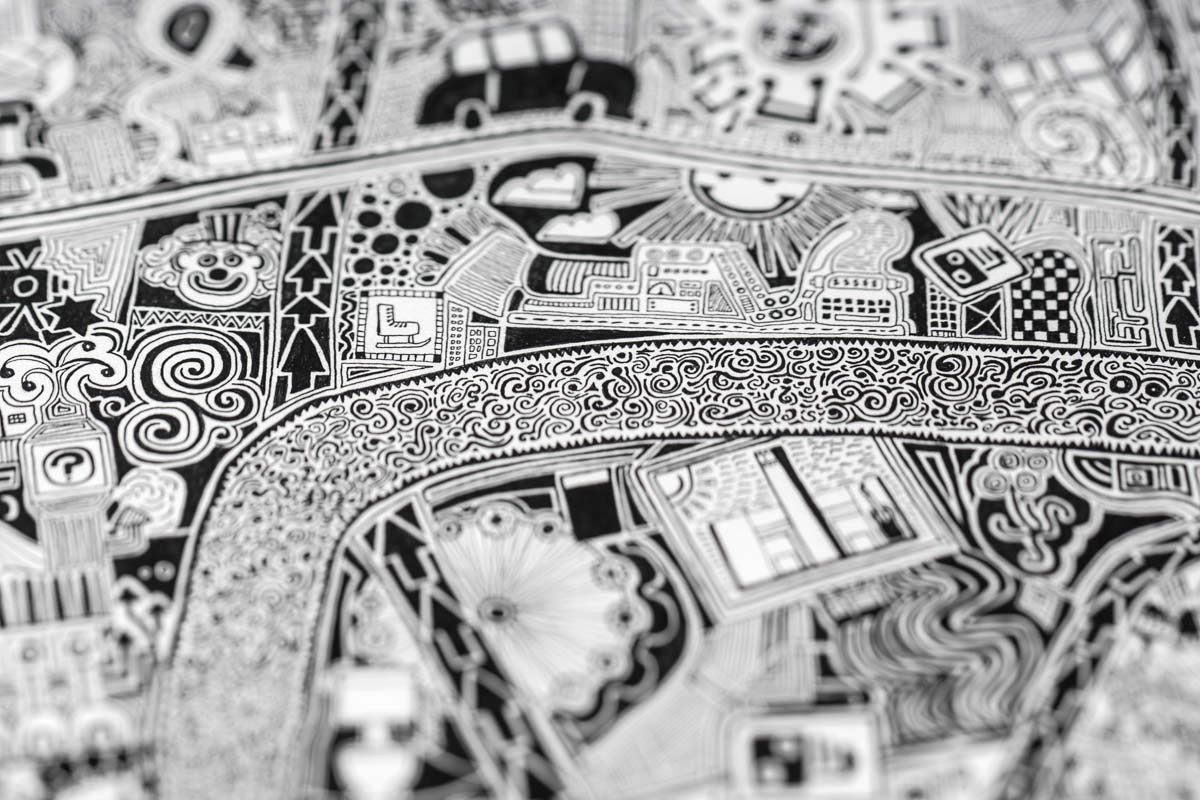Map Monday: A Swirling, Hand-Drawn, Impossibly Detailed London Map

Fuller’s map, London Town. (All images: Fuller Maps.)
For the last decade, artist Gareth Wood, also known as Fuller, has been hand-drawing a map of London with a black ink pen.
The finished work, “London Town”, which measures about four feet by three feet, is not geographically precise, and it ignores many of London’s most famous landmarks. What it does do, however, is capture the emotional essence of a city that’s in constant flux.

An iconic black taxi cruises above bicycle super-highways of the regenerated docklands. The pair of scissors and sliced limes represent a stretch of canal known as the Limehouse Cut.
Influenced by the aesthetics of the psychedelic movement, Fuller’s swirling, tightly packed lines portray a city that is chaotic and exuberant. Fuller, who began working on the map at the age of 25, calls it an “homage to youth.”

A big pig floats above Battersea Power Station, a reference to the imagery of Pink Floyd’s album Animals.
In deciding what imagery to include, omit, or emphasize on the map, Fuller delved into his own relationship with the city. During his post-adolescent years, he lived, worked, and meandered all over London. These personal experiences of the metropolis have guided his map-drawing hand and determined the layout and features of “London Town.”
“The city is very chaotic,” he says, “but I think the mind during those years can be very chaotic.” His own memories of the daily grind; late-night adventures; thwarted love; personal loss—all of this is represented on the map via imagery that ranges from the straightforward to the cryptic.

The crossed-fingers symbol, the logo of the National Lottery, is used in place of the Millennium Dome to express the public’s hope for the project, which has been met with disappointment over the years.
This weaving in of personal events and emotions among the geography creates what Fuller calls a “game-like element” for viewers of the map. Though they are welcome to guess what images mean to the artist, ideally they will “make up their own stories within the work and relate to it on their own level,” says Fuller.

Frenetic swirls north of the Thames, including the Olympic stadium at right.
One example is a serene, mod-styled woman shown in the map’s northeast. To the viewer, this could represent the Angel Tube station, with its many nearby bars, or the popular Camden Market–the psychedelic style fits with the aesthetic of the neighborhood. The woman actually does represent Angel, says Fuller, but also has a much more personal resonance—Fuller once owned a t-shirt with that same face printed on it, and wore it all around London, including to late-night dance clubs, where it got “covered in sweat.”

A huge birdcage represents Canary Wharf.
In addition to including experiences from his own life in the map, Fuller has been careful to include a more collective understanding of the city. Before uncapping his ink pen and drawing a new section of the map, he walked around the neighborhoods, formed his own impressions, had conversations with locals, and paid attention to what was being said in the media. Then, after a quick check of the basic geography he needed to depict, he drew.

The swirling River Thames winds through the map.
Drawing a neighborhood without experiencing it first-hand was never an option. “I don’t think it’s fair to the people that live there, because I wouldn’t be able to do their area or their community or their environment the justice it deserves,” says Fuller.
Though he did refer to Google Maps for “specific little bits of information” when drawing, that was just for the basic layout—his intricate ink lines always prioritize emotional resonance over cartographic accuracy.

The Aylesbury housing estate in South East London.
“London Town” is Fuller’s third major map project. His role as a map artist, he says, is to “narrate and observe the identity of places.” This can be a big challenge in a city like London, where the physical and cultural landscape is always changing. “The city is forever living and breathing and evolving,” says Fuller, “so it’s almost impossible to capture the real relationship with the place.”
Fuller’s London map is on view at St Pancras Clock Tower in London beginning on September 18, then at the Royal College of Art in December. The video below gives an intro to the map-making process, with each of the ten Big Ben chimes representing a year in the decade-long time frame.
Map Monday highlights interesting and unusual cartographic pursuits from around the world and through time. Read more Map Monday posts.












Follow us on Twitter to get the latest on the world's hidden wonders.
Like us on Facebook to get the latest on the world's hidden wonders.
Follow us on Twitter Like us on Facebook